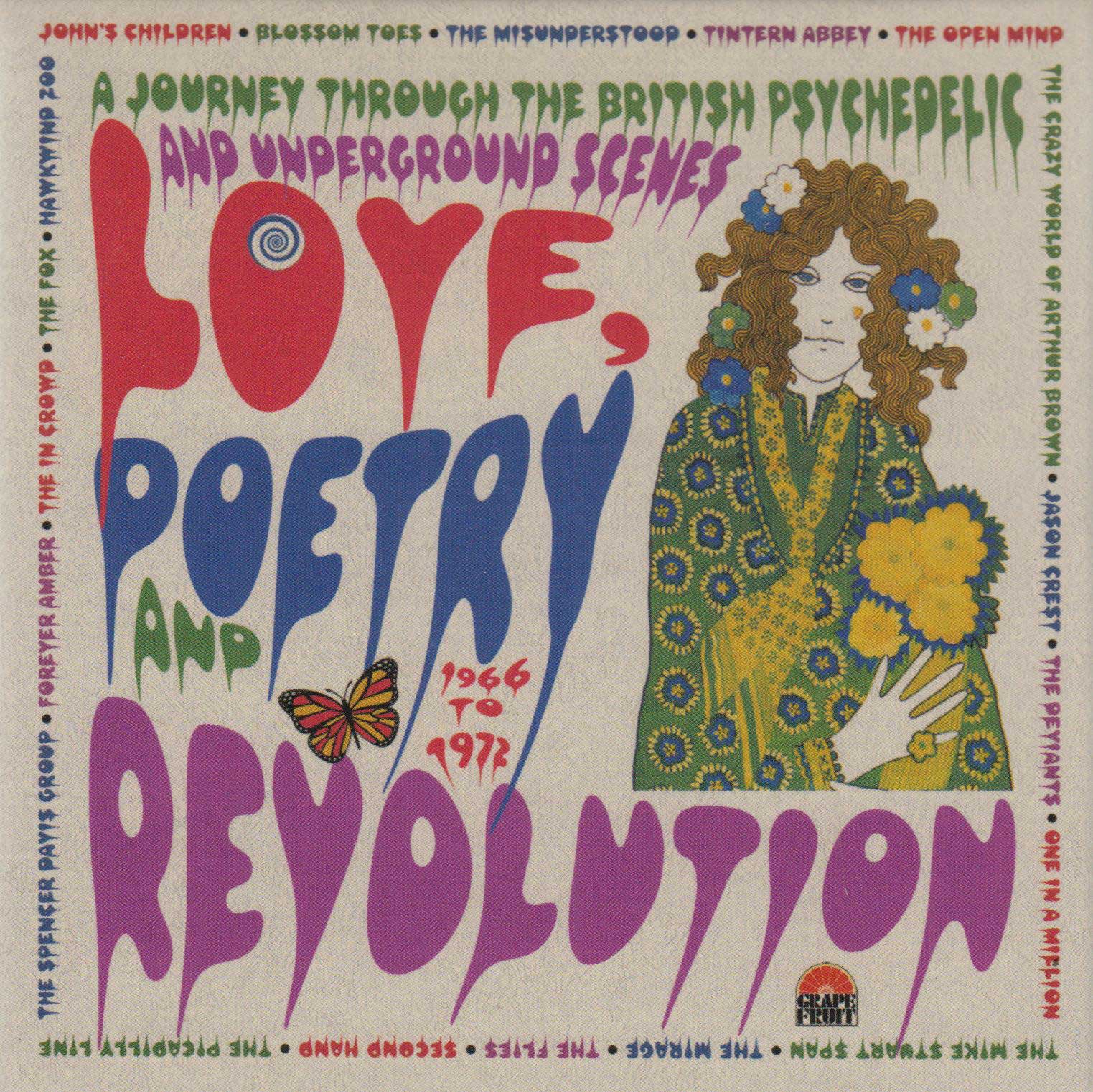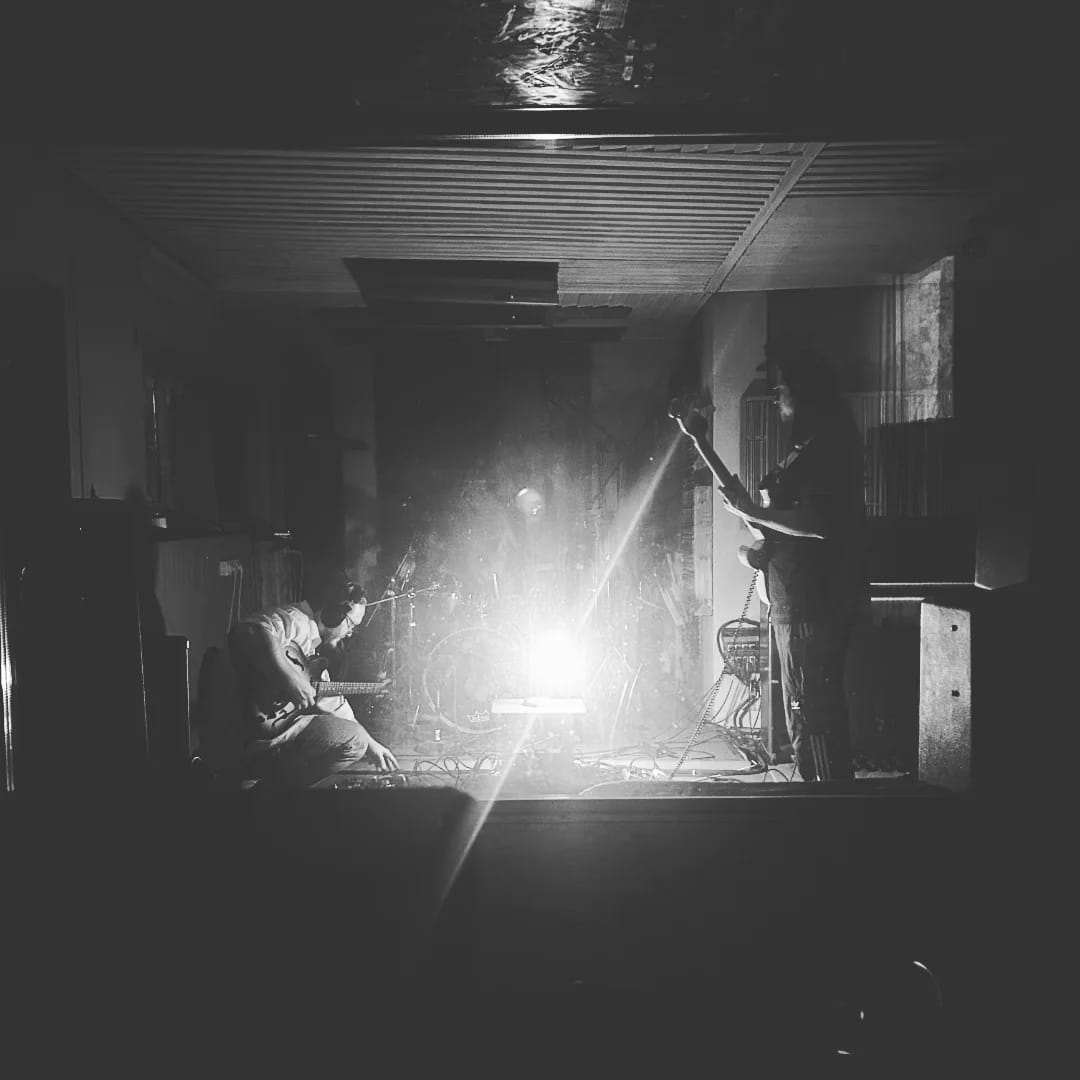‘Love, Poetry and Revolution: A Journey Through the British Psychedelic And Underground Scenes’
With the emergence of CD box sets, two specialities seem to be rising to the top like natural selection. Perhaps one’s a direct result of the other, who knows, but we now have the best label compilations (Island, Vertigo, Harvest, Dandelion, Dawn etc.) along with current labels compiling genre anthologies. Just released by Grapefruit Records, under the Cherry Red umbrella, is Love, Poetry and Revolution, a triple-CD clambox dedicated to British psychedelia from 1966 to 1972. And it’s a rare beast too.
As with all bestiaries, classification isn’t usually high on the list until zoology establishes where to fit what’s found. After all, who could imagine that a zebra is technically a camel or that a koala isn’t a bear? Popular music is no different at a time when histories are being compiled and co-ordinated thanks to hindsight and records from archaeological digs. Psych is usually defined as free-use of effects like fuzz, wah-wah, reverb, phasing and other tape tricks, with occasional use of exotic instruments. A fuzz tone pedal was first used in 1965 apparently—I’m no historian—but kindred effects appeared over a decade before with the amplifier as a source, such as on Ike Turner’s Rocket 88 and Chuck Berry’s Mabellene; my particular fave is the one man band Joe Hill Louis’s Boogie In The Park, an astonishing rocker from 1950 leaving Bill Haley without a paddle.
Psych was first coined in late 1965 with the 13th Floor Elevators of Texas, but as it gained ground split into two variants: popsike and underground (Edgar Broughton Band, Amon Düül, Pink Fairies, Quintessence, Stray etc.). The second form had no claims on the charts—so they said—and ‘to sell out’ was unforgivable treason, signalling different markets at one fell swoop. Fans were staunchly possessive of their own preference. This box set makes no distinction between the two strands, though surely “underground” doesn’t apply to bands who simply, and sadly in many cases based on what’s here, were unable to get into the charts. This, of course, may be hair-splitting. Psych is also supposed to reflect the experience of psychedelic drugs, but there’s little that is “crazed” in the results here. Definitions blur, and sub-divide, with freakbeat, mod-psych, and prog—or is the latter only when extended beyond three minutes? Today there’s also the derivative popsicle. As the booklet shows, a typical week at the Marquee could see Elmer Gantry (a noticeable absence here), Jason Crest (who are), Blodwyn Pig, Van Der Graaf Generator, Sonny Terry & Brownie McGhee, another week with Traffic, The Nice, Ten Years After, The Open Mind, and London Youth Jazz Orchestra. Heady days indeed! At first glance there seems no rhyme or reason to this issue. No anniversary, noticeable shift or itch to reappraise what’s been forgotten, nought—except darn fine taste with some amazing archive discoveries including bands unable to issue any recordings.
Perhaps the revival of the genre heralds it? Neo-psych is enjoying a high profile since the 90’s (Elf Power; Kula Shaker) to today’s overdrive with Tame Impala, Goat, Fuzz, Toy, Hidden Masters, Wooden Shjips, the staggering Nebula, even the North Mississippi Allstars who boogie-fuzz the blues like there’s no tomorrow in the wake of their mentor R.L. Burnside. Grapefruit’s David Wells traces Britain’s ancestry with some tasty comestibles on this “trail of breadcrumbs” as his only map.
Technicolor suddenly exploded on monochrome mid-60s Britain when not only society but musical expression felt a need to spread its wings in the wake of revivals of blues and folk music. Clubs and universities opened their doors before festivals climbed on the bandwagon, pop covers morphed into experimentation, rock, and fusion with jazz and other styles from as far away as India and Japan. The only order of the day was choice, for musicians and audiences alike. At a time when the rebellious decided not to stand for the national anthem in the cinema, and you could smoke there or on the plane because they had more sophisticated air-conditioning that sucked instead of blowed poisonous chemicals, the new style spread even into fashion and musty BBC who could no longer miss what was in front of their eyes. A revolution of arriving without travelling, as Harrison put it.

This is a compilation of trip-seeking pioneers, and their tales are as interesting as what they produced. There are household names (now) along with names not familiar in their own households. The first CD appropriately kicks off with Deep Feeling, a Midlands band that spawned such classics as Traffic, Spooky Tooth, Family and Blossom Toes. Their Pretty Colours featured on Luther Grosvenor’s anthology Floodgates a few years ago, and some of their unrealised ideas were revived in early Traffic in 1967. Sunbeam Records have issued all their known recordings based on the later DJM LP of 1971. The fascinating www.brumbeat.net (which has some of the funniest memories of small bands anywhere on the net) highlights the important history of a band that first started as The Hellions. When Eric Burdon was played the acetate of Pretty Colours he described it as psychedelic, thus spreading the word of this new style in the Black Country.
Legendary acts feature as often as those only vaguely known in legend. The Californian five-piece The Misunderstood, brought to Blighty by the raving (about them) John Peel, still only recorded a handful of songs in ’66 of which this track highlights effective use of different-tempo hand-clapping. An early 45 on a fledgling United Artists and chugging ’68 LP track by the influential Spencer Davis Group are keyboard driven, as is The Crazy World of Arthur Brown’s Devil’s Grip, their debut single, and flunked follow-up to Fire in late ’68 (Nightmare). Tread Softly For The Sleepers by the Hi-Fis is in the same vein, issued by the German Star Club no less when spending most of their short life on the Swiss-German border. The Mirage, an early backing band for Elton John but had several singles in their own right, adapted keyboard interest by employing the variant harmonium for a lovely Wedding of Ramona Blair (presumably no relation) and more standard fare on the unreleased Ebeneezer Beaver which, alas, fades out just as a superb guitar solo appears. Great wah-wah guitar livens up the Respect’s unreleased studio take from the summer of ’69.
The last of the four acts featured twice are The Deviants, an untypical ballad from their debut platter and the Stable-issued track that backed Mick Farren’s A-side Let’s Loot The Supermarket, proto-punk with a vocal style recalling Can’s Monster Movie. Other legends include Alan Bown, a pre-Bolan B-side of John’s Children, and Serendipity, a sextet with links to Blodwyn Pig and pre-Deep Purple Mandrake Root, on a hypnotic fuzz guitar and keyboard romp. The In Crowd—lined up to feature in not one but two films, then elbowed out of both—soon became the better-known Tomorrow, after changing style to go with the flow of The Who, Yardbirds, and Hollies on three Parlophone singles. By then the future Yesman Steve Howe and Twink (Pretty Things, Deviants, Pink Fairies, a true undergrounder) were in the band often featured on Peel’s Perfumed Garden. Tomorrow was the first-ever act on his Radio One show in ’67, their My White Bicycle being a later hit for Nazareth. Different styles are clear with The Drag Set, who rehearsed with Hendrix and fated to record with Joe Meek just a few days before his suicide; their early Santana-like guitar contrasts with the pre-CSNY of Felius Andromeda’s beautiful melody. Drag Set became the legendary Open Mind, whose classic stomper Magic Potion is also featured.
Mike Stuart’s Span leads with fuzz bass, but due to Decca’s odd apathy the Brighton group became better known as Leviathan, whose heavy origins are shown here. Surely the laurel for the unluckiest act never to achieve a contract in spite of frequent gig-page appearances goes to the Welshmen of Jade Hexagram. The storming Crushed Purple is resurrected from their Marquee tapes in 1968. One In A Million’s demo Man In Yellow features a teenage Jimmy McCulloch before Thunderclap Newman / Stone The Crows / Wings and an overdose at a younger age than Hendrix. This was recorded the same year as their 45, a style befitting their support of The Who’s first Scottish tour (McCulloch later recorded with them). Clifford T. Ward’s career is spotlighted with Simon’s Secrets’ Naughty Boy (CBS 1968), one of numerous non-charting singles in a career hampered by camera-and-tour-shyness then finally blighted by multiple sclerosis, when he literally crawled to his studio to record his final album.
Another rare gem is Neon Pearl, featuring Peter Dunton of later T2 fame, a seminal band on the touring scene. Unusually this is an acoustic track—the only one on the first CD—without drums, T2 being one of the few with a drummer-vocalist-principle songwriter. His melancholy, hypnotic vocal clearly hadn’t changed by the time he incarnated into the rocking It’ll All Work Out In Boomland (Decca) three years later, though with The Flies he approaches T2 without the searing guitar crescendos. The weirdest name prize has to go to Crocheted Doughnut Ring, whose Polydor release Two Little Ladies (Azalea and Rhododendron) is as musically innovative as the name is silly, almost a psych anthem in itself. They even flogged the absurd theme on Simon Dee’s TV show, to what purpose remains lost in the mists of time—or just in the mist. It came with the territory, as with the early demo by Blossom Toes hoping not to be late for tea, a hardy perennial period theme, Sand’s Mrs Gillespie’s Refrigerator penned by the Bee Gees, or The Shame’s homely advice to a little girl proffered by Greg Lake. After all, it was the era of basin hair-dos, collarless suits and Carnaby ties.
Equally rare is Tintern Abbey’s Busy Bee demo for what later became Beeside c/w Vacuum Cleaner (Deram 1967), their only release and deemed by many the archetype psych single. In spite of financing by a millionaire associated with the International Times underground paper, Tintern performed no UK gigs. The demo was recorded at R.G. Jones in Morden, Surrey, a hundred yards from my school and next to a 17th century churchyard and, more usefully, an ancient inn. The first demos by the Yardbirds, Stones and Stray were recorded there, as well as Quo and even Sonny Boy Williamson before the studio was demolished by the council for a hideous college. Jones relocated to Wimbledon, finally shutting shop a decade ago when one of the country’s oldest and most prestigious studios. After its debut was voted Melody Maker’s folk album of the year, the in-house Oak Records issued The Bo Street Runners (Mick Fleetwood, Mike Patto, Tim Hinkley), and The Gremlins (featuring the later Fleur de Lys’ vocalist). The Story of Oak Records, An Anthology of R.G. Jones (Morden) Recordings featured The Mike Stuart Span and Nico/Cale-like Velvet Frogs.
The second CD continues the chronological, eye-opening trail through personnel histories as they incarnate on different demos and singles. A classic example is the aforementioned Pete Dunton, reappearing in The Flies when he penned both sides of their ’68 RCA single. The East Londoners blagged important support gigs, including Hendrix at the Roundhouse, and some see the seeds of garage-punk in their 65-68 work highlighted on a CD release in 2002. Dunton then went on to Please for a fistful of demos—Strange Ways here is a melodic treat—before jumping ship for the better-known The Gun with the Gurvitz brothers, the remainder forming Bulldog Breed and also Infinity for a still-born concept album about space, matter (Arthur C. Clarke) and…curry (East End). Their Venetian Glass, written by keyboarder John Da Costa (his autobiography is at the Psychspaniolos blog), featured in their constant gigging when with the NEMS agency. Sun Dragon’s contribution from their one LP Green Tambourine (MGM 1968) featured Blackmore, Lord and Paice of Deep Purple, while Shy Limbs’ CBS single Love, in the vein of Manfred Mann and Procol Harum, sees Greg Lake on bass/vocals (as also with The Shame). Soon after he joined King Crimson whose Robert Fripp, also from Bournemouth, adds guitar here.
At first glance West Coast Consortium seem Californian in looks and la-la’s but were a North London male quintet specialising in harmony pop. After Pye changed their name from Xit and told them to “cut out the hippy tosh”, they had a no.22 UK hit in early ’69 but the chosen track is from unused home recordings six months earlier. Consortium soldiered on until 1975 trying to get an LP out, so it’s ironical that three CDs have been devoted to them since (on Angel Air, Castle, Wooden Hill). Kent’s Jason Crest (1967-69) suffered the same fate from Philips, even though one single —among five in 18 months—was translated into a French chart-topper while doing BBC shows and touring Germany. Their unreleased Teagarden Lane, swirl-phased with confident vocal harmonies like Barclay James Harvest, is one of less than 20 songs highly-rated by psych collectors. The frustration might be seen when one of them joined heavy merchants Orang-Utan.
Named after a 1940s novel and film set in 17th century England, Forever Amber’s The Love Cycle seems loosely based on that romance, certainly for the brashly sentimental track here. Appearing in January 1969 in only 99 copies to avoid VAT, the subsequent fame is almost staggering. Mojo, The Times, and The Guardian have all listed it as one of the great albums of the period, if one can get past the moronically world-ignoring “to hear before you die” buzz expression. It’s pretty nifty for a 16-track slice of vinyl costing £200 after 19 hours of studio work in Cambridge, when only the final track clambers to anywhere near four minutes. A more subterranean fame marks Second Hand’s A Fairy Tale and here is a demo of the title track. Their follow-up LP Death May Be Your Santa Claus, organ-based (sometimes exclusively) with Lol Coxhill guesting for the odd jazz flourish, was a film soundtrack based on a young black militant’s nihilism. Both housed in weird covers, they were akin to Arthur Brown’s Galactic Zoo Dossier of the same year and Beefheart; heavy psychedelic could have been coined just for them. Nurse With Wound cite Second Hand as an inspiration.
Mushroom Records formed especially to release a thousand copies of it in 1971, gaining further kudos when bringing out the classic Magic Carpet too from their offices opposite the Roundhouse in Chalk Farm (Alisha Sufit still performs interesting work today with her own label, Magic Carpet Records). Simon Finn’s Pass The Distance was their second release, but withdrawn due to a dispute over the artwork. His Laughing ’Til Tomorrow shows how regrettable that was; he later emigrated to Canada and turned his back on the industry. Talking of labels, a few choices appeared on the eclectic Beacon Records (1968-72), most renowned for the first albums of UFO when more spacey psych. The Fut’s 7” Have You Heard The Word (1970) appears on numerous Beatles bootlegs after Yoko Ono tried to copyright it as Lennon’s in 1985. In fact it was the result of a drunken Australian session with one of the Bee Gees, leaked to Beacon without their knowledge. Taiconderoga’s Whichi Tai To (Beacon, 1969) seem early precursors of dyslexia—their name misspells a US town (or a Witkacy novel character) and their song title (Maori?) couldn’t have helped. In true Beacon mode, it was a one-off by Train, a hard-gigging five-piece at the heavier end of late psych/early prog. Their drummer went on to Gentle Giant while the 18 year-old guitarist changed his name, and age, when forming The Damned at the dawn of punk.
The Cortinas—their only 7” here was after Mick Taylor left—soon opted for the less racy name Octopus for a classic one-off LP on Penny Farthing. The original was messed up by the label so the CD reissue on Rev-Ola is the first-ever as the band intended with 10 bonus tracks. Not to be confused with a mid-70s German prog band of the same name—several names have since been nicked especially by American groups—they had a wide repertoire live, covering Neil Young, Cat Stevens, Yes, and Beatles! This is their Badfinger style. Complex, “Fylde’s leading group”, were one of the first to issue 99-copy private pressings so the rare demo Images Blue is welcome. Their songwriter Steve Coe later penned Monsoon’s hit Ever So Lonely.
Among the obscure on the second CD are those with longer-lasting influence, such as The Liverpool Scene, a loosely-defined ensemble that adapted musical forms for a poetry theatre mixing wry social satire with anarchic politics. They centred round Adrian Henri, whose old school tie network included many useful friends in the media, Andy Roberts (unduly neglected yet worked with The Beatles without credit) and Mike Hart whose two great albums on Dandelion hark back to The Liverpool Scene. Less known than The Scaffold, they believed the effect of a poem is more important than the poem itself which works as an agent to convey the poet’s message (the French poet Rimbaud did the same, as did the Surrealists of course). John Cooper Clarke and Attila The Stockbroker were in the same vein, while the devastatingly humorous side reappeared on Hart’s solo LPs to good effect. (The box set has a hidden extra track—I’m guessing its Mike Hart’s family!) We’ll All Be Spacemen Before We Die, complete with NASA intro, is a rare cull from a ’69 TV series broadcast only in the north-west of England. Spacey, heavy Gong mixed with Tractor no less.
Also from Dandelion is Principal Edward’s Magic Theatre with one of the red label’s first singles, the violin-led Lament For The Earth. The commune group from the University of Exeter were also multi-media like the Liverpudlians but with less humour and, it’s said, more arrogance. Their second LP was produced by Floyd’s Nick Mason, a fan at the time. This reviewer considers them rather more typical of the counterculture than The Liverpool Scene, but the beauty of this fine collection is its allowance for different viewpoints. The closer by Kevin Coyne, Evil Island Home, is a mesmeric take on modern life as powerful today as when recorded for his first solo album at the end of Dandelion’s days. Completing the label connection is Beau (i.e. Trevor Midgley) with the title-track from his second LP, Creation, which featured the legendary Tractor duo adding pumped-up fuzz, a fusion style he still sporadically reprises today. From his (and Dandelion’s) debut single in the summer of ’69, 1917 Revolution where the guitar echoes the cavalry, to his current work on Cherry Red and Fruits de Mer, this master of the 12-string is enjoying (like Fry) a belated but well-deserved renaissance seen with Fables and Façades. His always-interesting material reflects life in the Britain of its day along with historical subjects unearthed from the past for a thought-provoking journey.
Hardin-York, organist-singer and drummer respectively of the Spencer Davis Group, pursued a career as a duo often seen on ’70s tours and in clubs like the Marquee. Their first single on Bell, Tomorrow Today, exemplifies what should have achieved wider notice. Mike Read’s fledgling period as a song-writer is given an airing with an unreleased demo, before his days as a TV presenter and DJ. Ex-Amber and The Lost, his track features Atomic Rooster’s later drummer and Virgin Sleep’s acid guitarist for a surprising What The Dickens. Also better known for extra-curricular activities were Fat Mattress, formed by Hendrix’s bassist Noel Redding to showcase his own work. The 7” flute-swirling B-side is a good example of their creativity, as is a still-viewable German TV performance, with their shared lead vocals that had a very distinctive, original tone at the time.
The chronological approach shines a strong searchlight on the musical development. The second half, spanning the last two CDs, includes longer tracks with more acoustic material from duos like Hardin-York and Paper Bubble’s rare Deram LP. From Shrewsbury, Brian Crane and Terry Brake had a close link with The Strawbs when they were still The Strawberry Hill Boys in Twickers. Cousins and Hooper produced Bubble’s only album and toured together, so fans of early Strawbs may well enjoy this discovery along with the guitar-and-sitar of The Fox’s Butterfly. Solo artists continue with Phil Cordell where big label faith later delivered a UK #5 (as Springwater) and German #1.
Contrasts permeate this cross-section anthology, starkly shown by two names without marketing guile who were both art students. The hippy troubadour Bill Nelson’s Northern Dream was pressed in a mere 300 copies by his local record store in Yorkshire while his counterpart Mark Fry was recording in Italy for RCA. Nelson’s solo debut displays early his guitar skill, before he formed Be-Bop Deluxe. Today the local boy made good holds an annual Nelsonica event in the same town as that record shop. Mark Fry’s Dreaming With Alice, with its linking theme between songs, initially went unnoticed but has become a psych-folk classic of dreamy atmosphere and nostalgia laced with subtle sitar. Fans of this should check out Peter Howell & John Ferdinando’s Jabberwocky, where spoken voice and tape-looping perfectly complement Lewis Carroll’s surrealistic verse.
The last CD gives space to longer compositions, as the psych singles began to overlap with more experimental prog. Czar, the former Tuesday’s Children disappointed with lack of interest in their pop singles, debuted under their new moniker at the Marquee in January 1970 a month before recording Ritual Fire Dance. The four-piece toured with The Moody Blues, Floyd, Hendrix and early King Crimson, who all left their traces for a lone album on Fontana with one of the most reproduced sleeves of the era. It was recorded late night after gigs which may account for its darker atmosphere. Due to copyright reasons, this demo—based on a piece in a Spanish ballet—had to be left off the LP. Space rock fans certainly have in their archives Hawkwind Zoo’s seven-minute demo Hurry On Sundown, but it’s an inspired inclusion here because Dave Brock still retained his busking heritage on their debut when they dropped the Zoo appendage and cheekily spelled their name in marijuana leaves. An edited version was their first single and featured in a debut Top Gear in August 1970. Kula Shaker (Hari Om Sundown) and The Petals later did versions of the underground anthem.
Highlights of course depend on your bag. History, nostalgia, style, music genealogy or just the music itself: something for everyone as the saying goes. It’s a British Nuggets trip without sitar swirlers, a cultural tapestry too though the threads are still pulling today. The booklet is a well-researched 36-page compendium full of atmospheric iconography—even the CDs can be easily removed from the packaging! No track times, but four hours of rare material, some restored to full-length from master-tapes for the first time along with period-pieces like an Alice Through The Looking Glass concept and a local TV soundtrack, region-only issues, and intriguing hidden track. The release is dedicated to Mick Farren, a true counterculture icon who stuck by his guns for half a century. The music like the message continues the same way.
– Brian R. Banks
Love, Poetry And Revolution: A Journey Through The British Psychedelic And Underground Scenes 1966 – 1972, Various Artists, 3CD Clamshell Boxset (Grapefruit Records, 2014)




Tintern Abbey definitely played dates in the UK. Not sure where the writer of this piece found his info on the group, but the article is incorrect in this matter. They were a noted presence on the circuit, their name adorning many a flyer 🙂